What is a Watershed?
Purpose of Watershed Protection
Lake Huron Watersheds
Bi-National Partnership
Contact Us
Home > Pollutants > Invasive Species > Aquatic Invasives
Zebra Mussel | Quagga Mussel | Round Goby | Eurasian Ruffe | Rusty Crayfish Spiny Water Flea | Fishhook Water Flea | Sea Lamprey | Asian Lady Beetle
Bloody Red Shrimp | Alewife | Viral Hemorrhagic Septicemia (VHS)
Zebra Mussel: The zebra mussel is a 50 mm 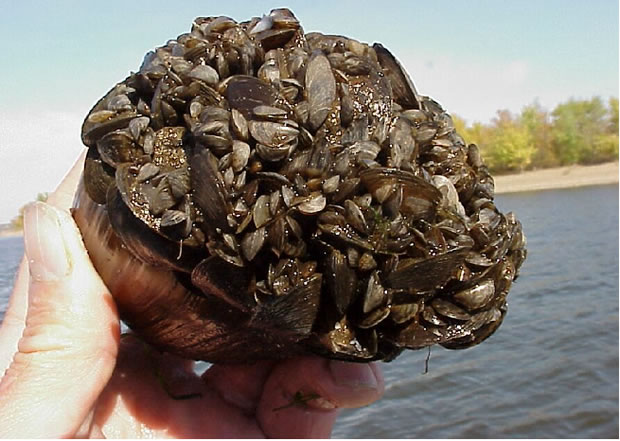 (Full Grown) mussel native to Russia that lives for four to five years. It is believed to have been introduced to the Great Lakes region in 1985 or 1986 through the ballast water of trans-oceanic vessels. Zebra mussels out-compete native organisms; they eat algae and filter out plankton, making the water clearer and disrupting the ecosystem. Zebra mussels consume considerable amounts of these beneficial microscopic organisms and this creates less food for larval and juvenile fishes that support sport and commercial fisheries. Clearer water forces light-sensitive fish deeper and increases populations of aquatic plants, which can cause problems for boaters. Zebras easily colonize hard surfaces. A mature female can produce up to one million eggs annually. Picture: U.S. Fish & Wildlife Service
(Full Grown) mussel native to Russia that lives for four to five years. It is believed to have been introduced to the Great Lakes region in 1985 or 1986 through the ballast water of trans-oceanic vessels. Zebra mussels out-compete native organisms; they eat algae and filter out plankton, making the water clearer and disrupting the ecosystem. Zebra mussels consume considerable amounts of these beneficial microscopic organisms and this creates less food for larval and juvenile fishes that support sport and commercial fisheries. Clearer water forces light-sensitive fish deeper and increases populations of aquatic plants, which can cause problems for boaters. Zebras easily colonize hard surfaces. A mature female can produce up to one million eggs annually. Picture: U.S. Fish & Wildlife Service
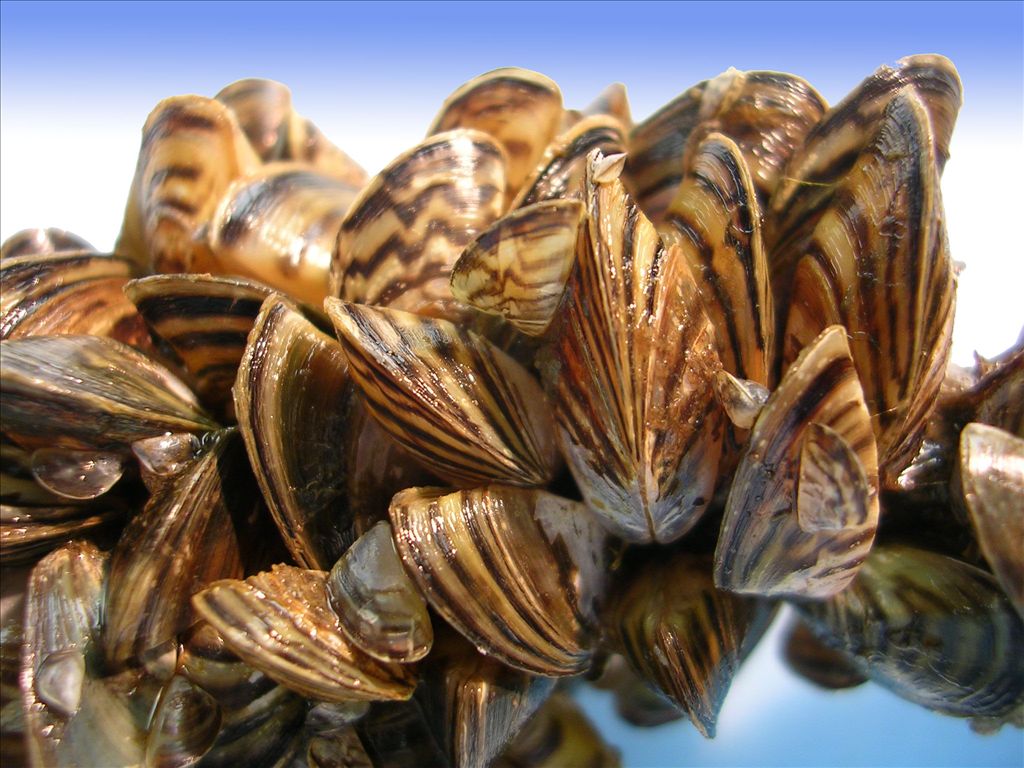 Quagga Mussel: The quagga mussel is a thumbnail-sized mussel native to Ukraine. It is believed to have been introduced to the Great Lakes region through the ballast water of trans-oceanic vessels. Quagga mussels outcompete native organisms; they eat algae and filter out plankton, making the water clearer and disrupting the ecosystem. Clearer water forces light-sensitive fish deeper and increases populations of aquatic plants, which can cause problems for boaters. Quaggas easily colonize hard surfaces. A mature female can produce up to one million eggs annually. Picture: 100th Meridian Initiative
Quagga Mussel: The quagga mussel is a thumbnail-sized mussel native to Ukraine. It is believed to have been introduced to the Great Lakes region through the ballast water of trans-oceanic vessels. Quagga mussels outcompete native organisms; they eat algae and filter out plankton, making the water clearer and disrupting the ecosystem. Clearer water forces light-sensitive fish deeper and increases populations of aquatic plants, which can cause problems for boaters. Quaggas easily colonize hard surfaces. A mature female can produce up to one million eggs annually. Picture: 100th Meridian Initiative
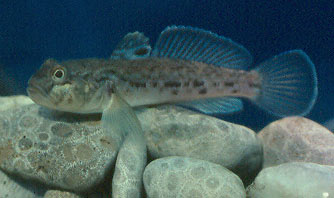 Round Goby: Round Gobies are bottom-dwelling fish that compete with other native bottom-dwellers, such as Sculpins and Log Perch. Round Gobies also prey on the eggs of other fish, like Smallmouth Bass; this contributes to the population decline of a multitude of sport fish populations. Picture: U of M Biological Station
Round Goby: Round Gobies are bottom-dwelling fish that compete with other native bottom-dwellers, such as Sculpins and Log Perch. Round Gobies also prey on the eggs of other fish, like Smallmouth Bass; this contributes to the population decline of a multitude of sport fish populations. Picture: U of M Biological Station
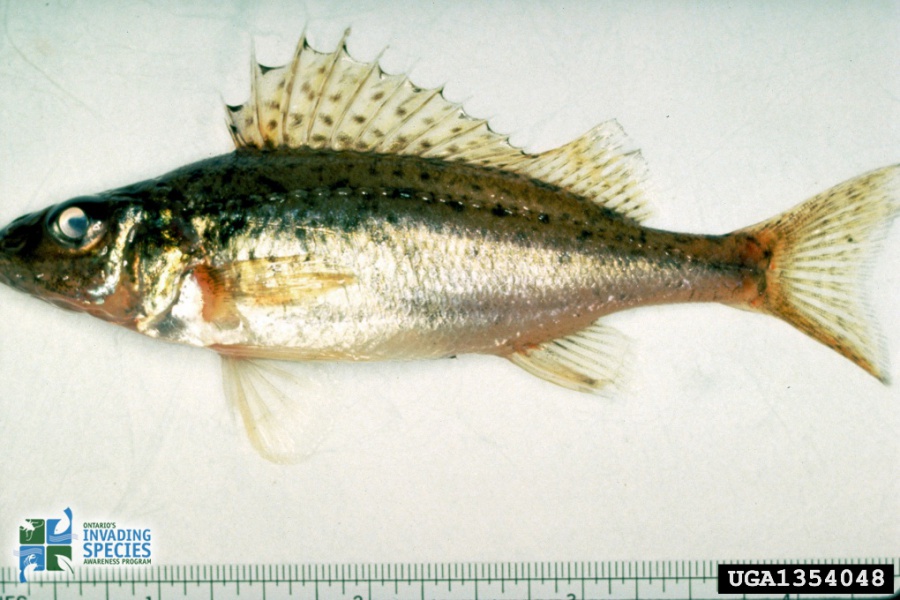 Eurasian Ruffe: A member of the Perch family, these fish compete with Yellow Perch and other native species for Zooplankton, the miniscule animals at the base of the food chain. Ruffes reproduce quickly and, because of their spiny and slimy bodies they do not make good food for native fish. Picture: Ontario's Invading Species Awareness Program
Eurasian Ruffe: A member of the Perch family, these fish compete with Yellow Perch and other native species for Zooplankton, the miniscule animals at the base of the food chain. Ruffes reproduce quickly and, because of their spiny and slimy bodies they do not make good food for native fish. Picture: Ontario's Invading Species Awareness Program
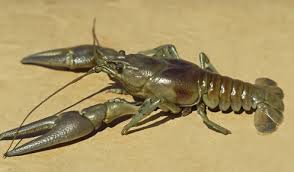 Rusty Crayfish: The Rusty Crayfish is native to Ohio, Kentucky and Tennessee. This species is spread by anglers who use it as bait; the Rusty Crayfish severely reduce lake and stream vegetation, which deprives native fish of food and cover. Rusty crayfish also deplete native crayfish populations. Picture: Great Lakes Information Network
Rusty Crayfish: The Rusty Crayfish is native to Ohio, Kentucky and Tennessee. This species is spread by anglers who use it as bait; the Rusty Crayfish severely reduce lake and stream vegetation, which deprives native fish of food and cover. Rusty crayfish also deplete native crayfish populations. Picture: Great Lakes Information Network
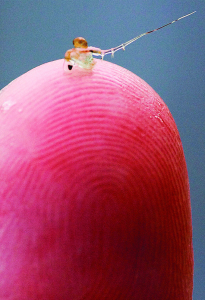 Spiny Water Flea: The Spiny Water Flea is a crustacean that originated from the lakes of Eastern and Western Europe and China, they invaded North America in the 1980’s and are now established in all the Great Lakes. The Spiny Water Flea grows to an average of 10 millimeters (0.4 inches) and feeds on other small aquatic animals that small fish depend on. Larger fish eat the Spiny Water Flea but they are difficult for small fish to ingest, potentially causing starvation. Picture: Northland Outdoors
Spiny Water Flea: The Spiny Water Flea is a crustacean that originated from the lakes of Eastern and Western Europe and China, they invaded North America in the 1980’s and are now established in all the Great Lakes. The Spiny Water Flea grows to an average of 10 millimeters (0.4 inches) and feeds on other small aquatic animals that small fish depend on. Larger fish eat the Spiny Water Flea but they are difficult for small fish to ingest, potentially causing starvation. Picture: Northland Outdoors
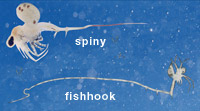 Fishhook Water Flea: The Fishhook Water Flea was discovered in Lake Michigan and Grand Traverse Bay in September 1999. This crustacean originates from the Caspian, Black, Azov and Aral Seas, and was most likely brought to the Great Lakes region through the ballast of ocean-going freighters. The Fishhook Water Flea is notable by its long tail spine which can reach up to ½ inch and the kink near the end of its tail. Like the spiny water flea the Fishhook Water Flea feeds on Zooplankton and is not easily ingested by small fish.
Fishhook Water Flea: The Fishhook Water Flea was discovered in Lake Michigan and Grand Traverse Bay in September 1999. This crustacean originates from the Caspian, Black, Azov and Aral Seas, and was most likely brought to the Great Lakes region through the ballast of ocean-going freighters. The Fishhook Water Flea is notable by its long tail spine which can reach up to ½ inch and the kink near the end of its tail. Like the spiny water flea the Fishhook Water Flea feeds on Zooplankton and is not easily ingested by small fish.
Picture: Minnesota Sea Grant
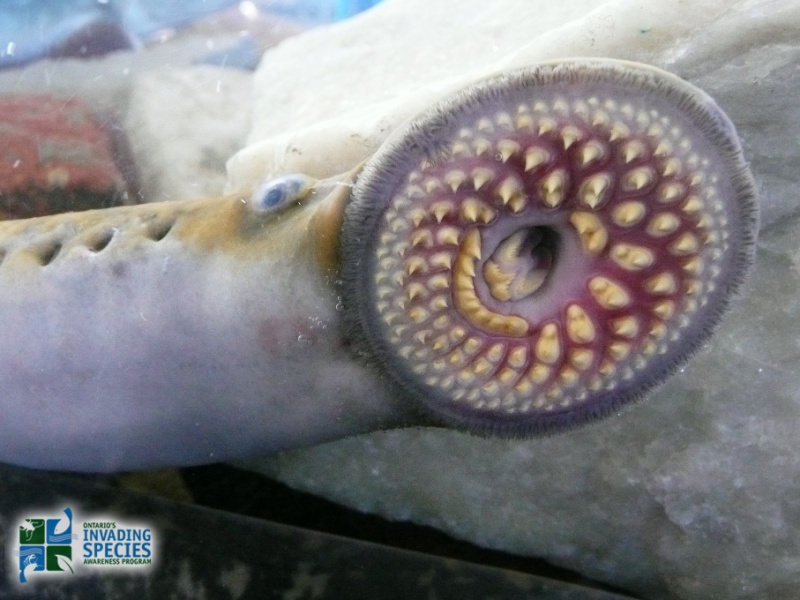 Sea Lamprey: The invasive Sea Lamprey parasitizes other fish by attaching its sucker-like mouth to suck out blood and body tissues. Lampreys can decimate populations of Lake Trout and other predator fish which allows for an explosion of smaller fish such as alewives. Chemical controls toxic to Lamprey larvae have been applied to spawning streams and electric weirs have been constructed in major tributaries throughout the Great Lakes in an attempt to control the Sea Lamprey. Locally, lampricides have been used in Mitchell Creek and the Boardman River. Picture: Ontario's Invading Species Awareness Program
Sea Lamprey: The invasive Sea Lamprey parasitizes other fish by attaching its sucker-like mouth to suck out blood and body tissues. Lampreys can decimate populations of Lake Trout and other predator fish which allows for an explosion of smaller fish such as alewives. Chemical controls toxic to Lamprey larvae have been applied to spawning streams and electric weirs have been constructed in major tributaries throughout the Great Lakes in an attempt to control the Sea Lamprey. Locally, lampricides have been used in Mitchell Creek and the Boardman River. Picture: Ontario's Invading Species Awareness Program
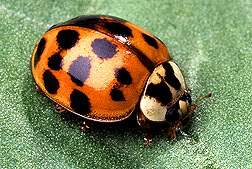 Asian Lady Beetle: This beetle is native to Asia but now can be found in many areas of the United States. This beneficial insect was imported and released as early as 1916 to naturally control certain insect pests. The first established populations of the insect were found in Louisiana in 1988 near the busy port of New Orleans. Accidental introductions have occurred via imported nursery items in Delaware and South Carolina. The multicolored Asian lady beetle can be an effective natural control for aphids, scale and other harmful plant pests. Unfortunately, its tendency to over winter in homes and other buildings can make it a nuisance. The beetles periodically become active during the winter and may invade bathrooms, bedrooms and kitchens. When agitated or squashed, these beetles may give off a yellow fluid and unpleasant odor that can stain walls and fabrics. Prevention is the best approach to dealing with these insects. Caulking exterior cracks and crevices before the ladybugs enter in the fall is effective. Sweeping and vacuuming will safely remove ladybugs that have already found their way into the home. Insecticides are not recommended. Ladybugs are attracted to light. Picture: USDA, Agricultural Research Service
Asian Lady Beetle: This beetle is native to Asia but now can be found in many areas of the United States. This beneficial insect was imported and released as early as 1916 to naturally control certain insect pests. The first established populations of the insect were found in Louisiana in 1988 near the busy port of New Orleans. Accidental introductions have occurred via imported nursery items in Delaware and South Carolina. The multicolored Asian lady beetle can be an effective natural control for aphids, scale and other harmful plant pests. Unfortunately, its tendency to over winter in homes and other buildings can make it a nuisance. The beetles periodically become active during the winter and may invade bathrooms, bedrooms and kitchens. When agitated or squashed, these beetles may give off a yellow fluid and unpleasant odor that can stain walls and fabrics. Prevention is the best approach to dealing with these insects. Caulking exterior cracks and crevices before the ladybugs enter in the fall is effective. Sweeping and vacuuming will safely remove ladybugs that have already found their way into the home. Insecticides are not recommended. Ladybugs are attracted to light. Picture: USDA, Agricultural Research Service
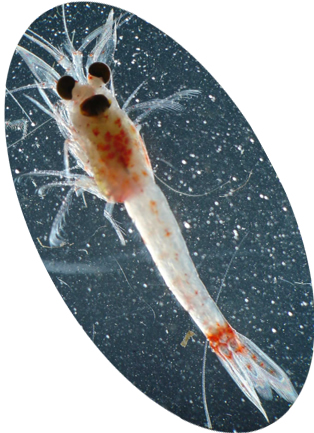 Bloody Red Shrimp: The “bloody-red shrimp” Hemimysis anomala, was first reported in the Great Lakes by NOAA from samples collected in Muskegon, Michigan in November of 2006 in waters connected to Lake Michigan. It is a small shrimp-like crustacean (order Mysidacea) native to the low-salinity margins of the Black Sea, the Azov Sea, and the eastern Caspian Sea and most likely was brought into the Great Lakes via ballast tanks. However, mysids are also used by aquarists as a high-nutrition food for aquarium fish, although we have not found any records that Hemimysis is used in this way. Picture: GLANSIS
Bloody Red Shrimp: The “bloody-red shrimp” Hemimysis anomala, was first reported in the Great Lakes by NOAA from samples collected in Muskegon, Michigan in November of 2006 in waters connected to Lake Michigan. It is a small shrimp-like crustacean (order Mysidacea) native to the low-salinity margins of the Black Sea, the Azov Sea, and the eastern Caspian Sea and most likely was brought into the Great Lakes via ballast tanks. However, mysids are also used by aquarists as a high-nutrition food for aquarium fish, although we have not found any records that Hemimysis is used in this way. Picture: GLANSIS
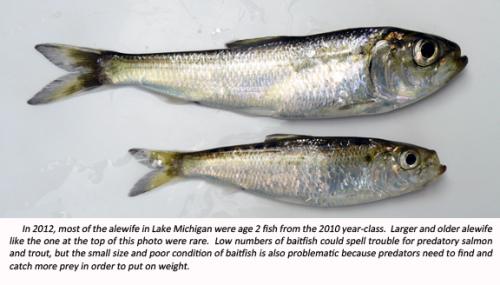 Alewife: The alewife is a small herring that is silvery blue/green in color. It has a dark back as well as light sides with horizontal dark stripes. This species can grow up to 15 inches (38 cm) in length. Inland populations, such as those in the Great Lakes, are usually smaller than 10 inches (25 cm) in length. Alewife is native to both saltwater and freshwater habitats of the Atlantic Coast from Labrador to South Carolina. In 1873, alewife was first identified from the Great Lakes in Lake Ontario. Some believe, however, that the alewife is native to Lake Ontario. Others think the Erie Canal or the stocking of fish may have led to the species’ introduction in the lake. Either way, alewife is not native to the other Great Lakes. Niagara Falls originally prevented alewife from spreading from Lake Ontario into Lake Erie and the rest of the Great Lakes Basin. The Welland Canal, opened in 1829, bypassed Niagara Falls and provided a route for their movement. By the 1950s, alewife was reported in all of the Great Lakes. The alewife is the dominant fish in Lake Michigan and accounts for 70-90 percent of the lake’s total fish weight. Picture: MSUE
Alewife: The alewife is a small herring that is silvery blue/green in color. It has a dark back as well as light sides with horizontal dark stripes. This species can grow up to 15 inches (38 cm) in length. Inland populations, such as those in the Great Lakes, are usually smaller than 10 inches (25 cm) in length. Alewife is native to both saltwater and freshwater habitats of the Atlantic Coast from Labrador to South Carolina. In 1873, alewife was first identified from the Great Lakes in Lake Ontario. Some believe, however, that the alewife is native to Lake Ontario. Others think the Erie Canal or the stocking of fish may have led to the species’ introduction in the lake. Either way, alewife is not native to the other Great Lakes. Niagara Falls originally prevented alewife from spreading from Lake Ontario into Lake Erie and the rest of the Great Lakes Basin. The Welland Canal, opened in 1829, bypassed Niagara Falls and provided a route for their movement. By the 1950s, alewife was reported in all of the Great Lakes. The alewife is the dominant fish in Lake Michigan and accounts for 70-90 percent of the lake’s total fish weight. Picture: MSUE
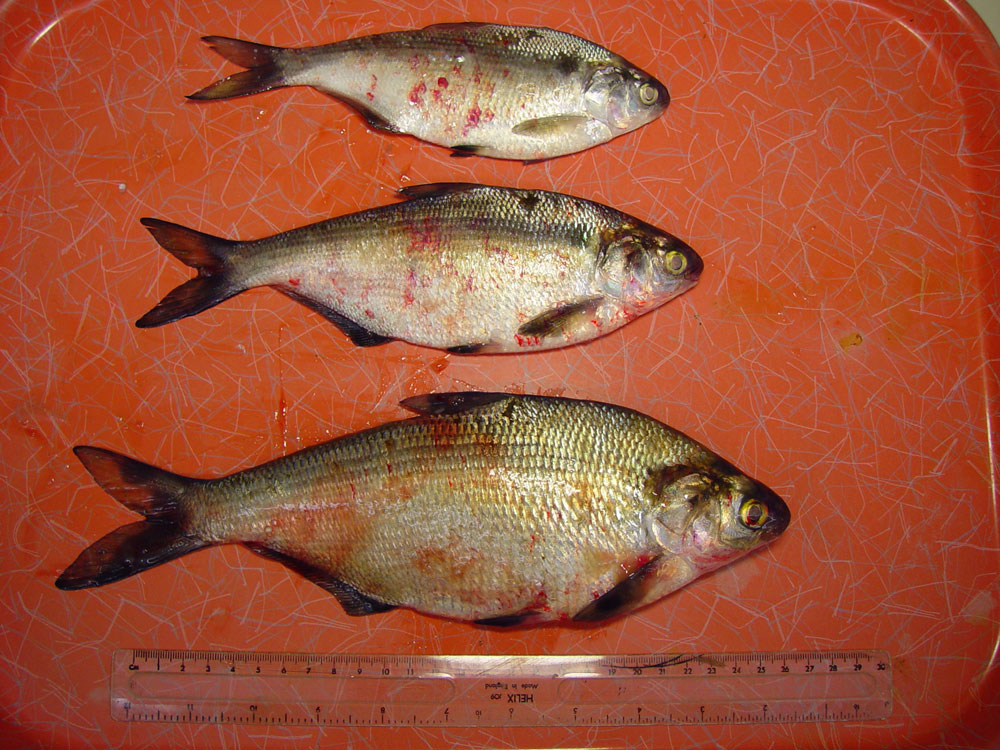 Viral Hemorrhagic Septicemia (VHS): is an extremely serious viral disease of fresh and saltwater fish. It has recently spread into the Great Lakes region of the United States and Canada. VHS virus has been found in Lake Huron, Lake St. Clair, Lake Erie, Lake Ontario, Lake Michigan, and the St. Lawrence River in New York. The virus also has infected several inland lakes in New York, Michigan, and Wisconsin. The disease can cause large-scale fish kills and have severe economic consequences.
Viral Hemorrhagic Septicemia (VHS): is an extremely serious viral disease of fresh and saltwater fish. It has recently spread into the Great Lakes region of the United States and Canada. VHS virus has been found in Lake Huron, Lake St. Clair, Lake Erie, Lake Ontario, Lake Michigan, and the St. Lawrence River in New York. The virus also has infected several inland lakes in New York, Michigan, and Wisconsin. The disease can cause large-scale fish kills and have severe economic consequences.
Picture: Iowa State University, The Center for Food Security & Public Health
Sources: The Watershed Center Grand Traverse Bay, Protect Your Waters & GLANSIS
For more information on these and other Invasive Species affecting Northern Michigan Watersheds please visit: Tip of the Mitt Watershed Council
Northeast Michigan Council of Governments
80 Livingston Blvd. | PO Box 457
Gaylord, MI 49734
(989) 705-3730 | nemcog.org


